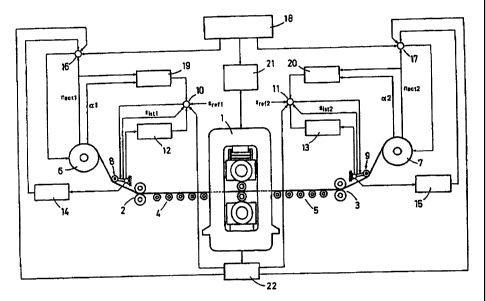Some of the information on this Web page has been provided by external sources. The Government of Canada is not responsible for the accuracy, reliability or currency of the information supplied by external sources. Users wishing to rely upon this information should consult directly with the source of the information. Content provided by external sources is not subject to official languages, privacy and accessibility requirements.
Any discrepancies in the text and image of the Claims and Abstract are due to differing posting times. Text of the Claims and Abstract are posted:
| (12) Patent: | (11) CA 2330099 |
|---|---|
| (54) English Title: | STECKEL HOT ROLLING MILL |
| (54) French Title: | LAMINOIR A CHAUD STECKEL |
| Status: | Deemed expired |
| (51) International Patent Classification (IPC): |
|
|---|---|
| (72) Inventors : |
|
| (73) Owners : |
|
| (71) Applicants : |
|
| (74) Agent: | RICHES, MCKENZIE & HERBERT LLP |
| (74) Associate agent: | |
| (45) Issued: | 2007-04-17 |
| (86) PCT Filing Date: | 1999-04-20 |
| (87) Open to Public Inspection: | 1999-11-04 |
| Examination requested: | 2004-03-11 |
| Availability of licence: | N/A |
| (25) Language of filing: | English |
| Patent Cooperation Treaty (PCT): | Yes |
|---|---|
| (86) PCT Filing Number: | PCT/EP1999/002652 |
| (87) International Publication Number: | WO1999/055474 |
| (85) National Entry: | 2000-10-23 |
| (30) Application Priority Data: | ||||||
|---|---|---|---|---|---|---|
|
The invention relates to a Steckel hot rolling mill comprising at least one
reversing roll stand (1)
as well as coilers (6, 7) which are positioned upstream and downstream and
present
torque-controlled drives. The aim of the invention is to improve such a hot
rolling mill in such a way
that it optimally counteracts variations in tension and/or mass flow caused by
changes in process
parameters and allows for high-quality hot rolling, especially of very thin
hot-rolled strips. To
this end the invention provides for a looper (8 9) to be positioned between
both coilers (6, 7) and
the reversible roll stand (1), which supplies actual values for adjusting
tension and mass flow.
L'invention concerne un laminoir à chaud Steckel comportant au moins une cage réversible (1), ainsi que des bobineuses (6, 7) placées en amont et en aval de celle-ci et possédant des systèmes d'entraînement dont le couple de rotation est régulé. Un tel laminoir doit être perfectionné afin d'empêcher de manière optimale les variations de tension et/ou de flux massique provoquées par les variations des paramètres du processus et de permettre également le laminage, notamment d'un feuillard à chaud mince, avec une qualité élevée constante. A cet effet, entre les bobineuses (6, 7) et la cage réversible (1) est disposé respectivement un couloir à boucles (8, 9) qui fournit des valeurs réelles pour la régulation en tension ainsi que la régulation du flux massique.
Note: Claims are shown in the official language in which they were submitted.
Note: Descriptions are shown in the official language in which they were submitted.

For a clearer understanding of the status of the application/patent presented on this page, the site Disclaimer , as well as the definitions for Patent , Administrative Status , Maintenance Fee and Payment History should be consulted.
| Title | Date |
|---|---|
| Forecasted Issue Date | 2007-04-17 |
| (86) PCT Filing Date | 1999-04-20 |
| (87) PCT Publication Date | 1999-11-04 |
| (85) National Entry | 2000-10-23 |
| Examination Requested | 2004-03-11 |
| (45) Issued | 2007-04-17 |
| Deemed Expired | 2015-04-20 |
There is no abandonment history.
| Fee Type | Anniversary Year | Due Date | Amount Paid | Paid Date |
|---|---|---|---|---|
| Application Fee | $300.00 | 2000-10-23 | ||
| Registration of a document - section 124 | $100.00 | 2001-02-05 | ||
| Maintenance Fee - Application - New Act | 2 | 2001-04-20 | $100.00 | 2001-03-27 |
| Maintenance Fee - Application - New Act | 3 | 2002-04-22 | $100.00 | 2002-03-15 |
| Maintenance Fee - Application - New Act | 4 | 2003-04-21 | $100.00 | 2003-03-13 |
| Request for Examination | $800.00 | 2004-03-11 | ||
| Maintenance Fee - Application - New Act | 5 | 2004-04-20 | $200.00 | 2004-04-01 |
| Maintenance Fee - Application - New Act | 6 | 2005-04-20 | $200.00 | 2005-03-29 |
| Maintenance Fee - Application - New Act | 7 | 2006-04-20 | $200.00 | 2006-03-31 |
| Final Fee | $300.00 | 2007-01-31 | ||
| Maintenance Fee - Patent - New Act | 8 | 2007-04-20 | $200.00 | 2007-04-12 |
| Maintenance Fee - Patent - New Act | 9 | 2008-04-21 | $200.00 | 2008-04-14 |
| Maintenance Fee - Patent - New Act | 10 | 2009-04-20 | $250.00 | 2009-04-09 |
| Maintenance Fee - Patent - New Act | 11 | 2010-04-20 | $250.00 | 2010-04-09 |
| Maintenance Fee - Patent - New Act | 12 | 2011-04-20 | $250.00 | 2011-04-08 |
| Maintenance Fee - Patent - New Act | 13 | 2012-04-20 | $250.00 | 2012-04-05 |
| Maintenance Fee - Patent - New Act | 14 | 2013-04-22 | $250.00 | 2013-04-08 |
Note: Records showing the ownership history in alphabetical order.
| Current Owners on Record |
|---|
| SMS SCHLOEMANN-SIEMAG AKTIENGESELLSCHAFT |
| Past Owners on Record |
|---|
| JEPSEN, OLAF NORMAN |
| SUDAU, PETER |